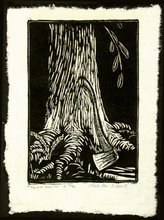As so often happens in my writing life, last night I was seized with doubt when I began typing one of the final chapters to the first draft of my current novel. Was I veering off course again? I pulled out my story structure template (waving to Amy) and rough Snowflake (Randy) and took a look at my log line.
A log line, sometimes called the pitch line or premise, summarizes a story in one sentence. Log lines keep a writer focused, and are necessary to have when people—from editors and agents to family & friends--ask what the story is about.
Sound simple? It wasn’t for me, at first. No matter how much time I spent on my log line, I was never satisfied with the wording of it. I decided to study this deeper, and see what examples I could find online. In my search, I discovered a wonderfully helpful article by Christopher Lockhart entitled I Wrote a 120 Page Script but Can’t Write a Logline: The Construction of a Logline.
About a log line, he says:
“It presents the major throughline of the dramatic narrative without character intricacies and sub-plots. It is the story boiled down to its base. A logline must present:
who the story is about (protagonist)
what he strives for (goal)
what stands in his way (antagonistic force)
Okay, that I knew. He goes on to say:
“Sometimes a logline must include a brief set-up. A logline does not tell the entire story. It merely uses these three (sometimes four) major story elements to depict the dramatic narrative in an orderly and lucid manner.
“Screenplays ask dramatic questions throughout the course of the story. These questions create tension and motivate the reader to turn to the next page. A logline does the same thing in miniature: it raises questions that evoke curiosity and stir up potentiality.
“A good logline (like the screenplay itself) should boast a story that is not dependent on its ending. Providing too much information in a logline can backfire by giving the executive more information in which to find fault. A brief but well constructed logline should tease and raise many questions to successfully pique the interest of the executive.” He also advises against using theme in the logline.
Amy Deardon, in her story structure template, calls the log line a “zinger” and says it should include irony if possible. (See if you can spot irony in the examples below)
Note: A log line is not to be confused with a tag line, which is a catchphrase used in advertising. Ex: JAWS II: “Just when you thought it was safe to go back into the water…”doesn't tell what the story's about.
Once I learned what makes a good log line, I decided, before boiling down my own story, I’d practice on some of my recent reads and old favorites. Stories I don’t have on hand or couldn’t remember well, I looked up on IMDb to get the log lines of their movie versions. These are noted.
I’m the type of person who needs a lot of examples to learn something, so my list is pretty long. Anyway, it was a fun exercise. I hope the following list will be useful to you as a writer, or even as a reader looking for a book you haven’t read.
Three by Ted Dekker: A brilliant but naïve seminary student searches his painful past for the confession demanded by a mysterious killer.
Turtle Moon by Alice Hoffman: Under the oppressive heat of Florida in May, a gutsy divorcee teams up with a reticent cop to find her runaway son and her neighbor’s murderer.
Girl with a Pearl Earring by Tracy Chevalier: A young maid with an aesthetic eye is hired to work for the wife of painter Johannes Vermeer but becomes his talented assistant and the model for one of his most famous works.
A Lever Long Enough by Amy Deardon: “A small military team travels back in time to film the theft of Jesus' body from the tomb.” (log line by the author).
Bel Canto by Ann Patchett: South American guerrillas invade a party at a government mansion and the prolonged captivity of their notable hostages produces surprising results.
Ladder of Years by Anne Tyler: A restless 40-year-old, feeling unappreciated by her husband and nearly-grown children, wanders off during a family vacation and starts a new life in a small town.
The Kite Runner by Khaled Hosseini: Amid the horrors invading his homeland, a wealthy Afghani boy moves from a close friendship with the son of his father’s servant to betrayal, and then to the hope of redemption in adulthood.
The Bonesetter’s Daughter by Amy Tan: A Chinese-American has a manuscript of her mother’s translated, and as the elderly woman slips into dementia, the daughter learns the truth about her mother’s past in China.
The Count of Monte Cristo by Alexandre Dumas: “A young man, falsely imprisoned by his jealous "friends," escapes and uses a hidden treasure to exact his revenge.” (IMDb)
The Secret Life of Bees by Sue Monk Kidd: A young girl's search for the truth about her dead mother leads her to three beekeeping sisters, the mesmerizing world of bees, and a mysterious Black Madonna.
To Kill a Mockingbird by Harper Lee: “In 1930’s Georgia, a young girl learns about racism when her lawyer father defends a black man falsely accused of rape.” (?)
The Assistant by Bernard Malamud: An Italian-American drifter is forced to re-examine his moral and spiritual beliefs when he falls in love with the daughter of his employer, the Jewish storekeeper he secretly robbed.
My Antonia by Willa Cather: The tale of a spirited, young Bohemian immigrant striving to make good in the untamed land of late 19th century Nebraska, as told through the eyes of her childhood friend.
The Life of Pi by Yann Martel: The spiritually-minded son of an Indian zookeeper struggles to survive and find land after he ends up in a lifeboat with a Bengal tiger.
The Member of the Wedding by Carson McCullers: A stubborn adolescent, longing at once for escape and belonging, dreams of joining her older brother and his bride-to-be in their new life together.
The Curious Incident of the Dog in the Night-Time by Mark Haddon: An autistic teen accused of killing his neighbor’s dog goes on an odyssey to track down the killer.
The Shipping News by E. Annie Proulx: An emotionally-beaten man moves with his young daughters to his ancestral Newfoundland home to reclaim his life. (IMDb)
The Lovely Bones by Alice Sebold: From the vantage point of heaven, a young girl observes her family, friends, community and killer in the aftermath of her murder.
Feel free to share the log line of your story, make up one for a favorite book, or try a humorous version like Richard Polito’s log line for The Wizard of Oz:
"Transported to a surreal landscape, a young girl kills the first woman she meets, then teams up with three complete strangers to kill again."









3 comments:
Love this post, Lydia! I can't wait to hear the log line you've come up with! What fantastic practice. I have to say the Wizard of Oz one is my favorite. :)
Lydia --
This is great! I learned so much from your post -- thank you for sharing this. Actually, if it's OK with you, could I repost it with credit/links?
Congrats on finishing your novel!
Amy,
Sure, use anything you wish.
Thanks for the congrats, but I'm not done yet. Maybe 2 more chapters to go. I wrote an entire scene while standing in the crowded metro this morning. That was fun. :)
Post a Comment